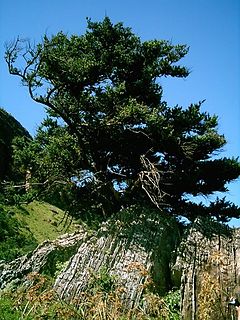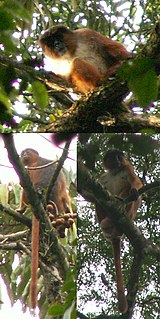Related Research Articles
The protected areas of South Africa include national parks and marine protected areas managed by the national government, public nature reserves managed by provincial and local governments, and private nature reserves managed by private landowners. Most protected areas are intended for the conservation of flora and fauna. National parks are maintained by South African National Parks (SANParks). A number of national parks have been incorporated in transfrontier conservation areas.

Taï National Park is a national park in Côte d'Ivoire that contains one of the last areas of primary rainforest in West Africa. It was inscribed as a World Heritage Site in 1982 due to the breadth of its flora and fauna. Five mammal species of the Taï National Park are on the Red List of Threatened Species: pygmy hippopotamus, olive colobus monkeys, leopards, chimpanzees and Jentink's duiker.

The Niokolo-Koba National Park is a World Heritage Site and natural protected area in south eastern Senegal near the Guinea-Bissau border. It is served by Niokolo-Koba Airport, an unpaved airstrip.

Loango National Park is a national park in western Gabon. It protects diverse coastal habitat, including part of the 220 km² Iguéla Lagoon, the only significant example of a typical western African lagoon system that is protected within a national park.

Dja Faunal Reserve, located in south eastern Cameroon, is a UNESCO World Heritage Site inscribed in 1987. Causes of inscription include diversity of species present in the park, the presence of five threatened species of mammal, and lack of disturbance within the park. It is managed by Dja Conservation Services (DCS), which is led by a conservator. The Reserve receives significant support for its management from many projects funded by international partners and supporters of conservation in Cameroon.

The Guinean forest-savanna mosaic is an ecoregion of West Africa, a band of interlaced forest, savanna, and grassland running east to west and dividing the tropical moist forests near the coast from the West Sudanian savanna of the interior.

The protected areas of Chile are areas that have natural beauty or significant historical value protected by the government of Chile. These protected areas cover over 140,000 km2 (54,054 sq mi), which is 19% of the territory of Chile. The National System of Protected Wild Areas is regulated by law #18,362 passed in 1984, and administered by the National Forest Corporation (CONAF).

The protected areas of Nicaragua are areas that have natural beauty or significance and are protected by Nicaragua. Nicaragua has 78 protected areas that cover 22,422 km², about 17.3% of the nations landmass. The National System of Protected Areas (SINAP) is administered by the Ministry of the Environment and Natural Resources (MARENA).

The wildlife of Cameroon is composed of its flora and fauna. Bordering Nigeria, it is considered one of the wettest parts of Africa and records Africa's second highest concentration of biodiversity. To preserve its wildlife, Cameroon has more than 20 protected reserves comprising national parks, zoos, forest reserves and sanctuaries. The protected areas were first created in the northern region under the colonial administration in 1932; the first two reserves established were Mozogo Gokoro Reserve and the Bénoué Reserve, which was followed by the Waza Reserve on 24 March 1934. The coverage of reserves was initially about 4 percent of the country's area, rising to 12 percent; the administration proposes to cover 30 percent of the land area.

Lagoa do Peixe National Park is a national park in the state of Rio Grande do Sul, Brazil. It was created in 1986 to protect a wintering zone for migratory birds along the Lagoa dos Patos, the estuary of the Guaiba river or Guaíba Lake about 200 kilometres (120 mi) south of Porto Alegre.

The wildlife of Togo is composed of the flora and fauna of Togo, a country in West Africa. Despite its small size the country has a diversity of habitats; there are only remnants of the once more extensive rain forests in the south, there is Sudanian Savanna in the north-western part of the country and larger areas of Guinean forest-savanna mosaic in the centre and northeast. The climate is tropical with distinct wet and dry seasons. There are estimated to be over 3000 species of vascular plant in the country, and 196 species of mammal and 676 species of bird have been recorded there.

The protected areas of Cameroon include national parks, wildlife sanctuaries, faunal reserves, and one flora sanctuary. Many protected areas in Cameroon are still in pristine condition, mostly because there is less tourism in Cameroon than other regions of Africa. According to reported statistics, there were ten protected areas from 1932 to 1960. Six protected areas were added between 1960 and 1980, five more were added between 1980 and 2004, and eight protected areas are under consideration within a final approval process.

The Guinean mangroves are a coastal ecoregion of mangrove swamps in rivers and estuaries near the ocean of West Africa from Senegal to Sierra Leone.

The Orango National Park is a protected area in Guinea-Bissau. It was established in December 2000. The park has an area of 1,582 km2 (611 sq mi), which is partly marine. It covers the southern part of the Bissagos Archipelago, notably the islands Orango, Orangozinho, Meneque, Canogo and Imbone, and the surrounding sea. The marine area does not exceed 30 m (100 ft) depth. The park is administered by: Instituto da Biodiversidade e das Áreas Protegidas da Guiné-Bissau. About 160 km2 (60 sq mi) of the park is covered by mangroves. It plays a crucial role for the reproduction of molluscs, fish and sea turtles.
The Lagoas de Cufada Natural Park is found in Guinea-Bissau. It was established on 1 December 2000. This site is 890 km². It was the first protected area in Guinea-Bissau.

The Cacheu River Mangroves Natural Park is a national park situated on the Cacheu River in Guinea-Bissau. It was established on 1 December 2000. This site is 886 km². The park has been designated as a Ramsar site since 2015.
Protected areas of Panama include:
References
- ↑ "Guinea-Bissau". Protected Planet. Accessed 18 June 2020.